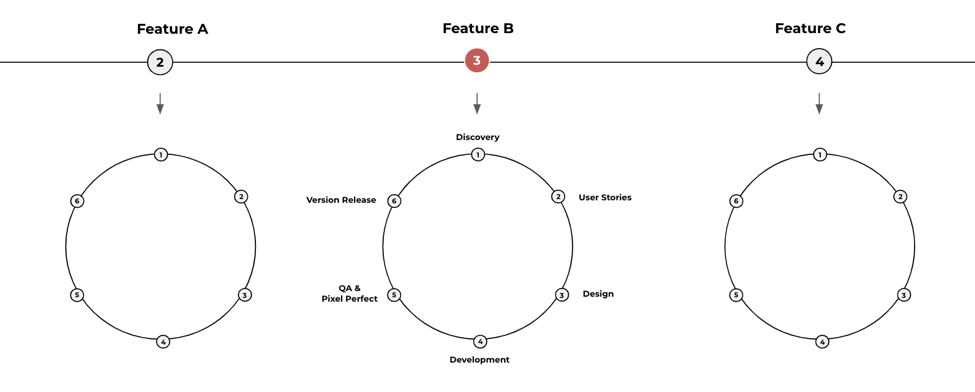Being Agile - This is How to Get Started
22.12.2019
.jpg)
In our previous article, we (hopefully) convinced you that in order to succeed in an ever-changing, fast-paced world, you need to work according to the Agile methodology when developing products, features, or anything else for that matter. In this article, we aim to give you some practical tools that will guide you in your first steps in developing a product.
The Agile product development process in Moveo
Our first step in Agile product development is the “Scoping” process, in which we aim to properly plan the product. The Scoping allows us to decide on which features we will develop and in what order.

Afterwards, we have the development of each feature according to a cycle that includes the discovery, user stories, design, development, QA, pixel perfect and version release phases.

Scoping VS Specification
In the previous article, we explained the the waterfall method for product development, and some of its disadvantages. It’s common that the work team plans the product end-to-end, before moving forward to the next phases. This is the specification process, which includes all the product’s aspects, edge cases, features and capabilities, that usually takes a few months. The specification stands in contradiction to everything the Agile methodology stands for and might lead to problematic situations in which unclear details regarding the product’s behavior on marginal pages delay the product’s development substantially.
Being Agile means not having to plan everything in advance. Instead, it suggests to break-down every project into smaller tasks, while maintaining the ability to respond to changes. This is why we adopted the Scoping process, a shorter procedure that aims to produce clear directions for the product’s next steps. The Scoping process prevents misunderstandings that may rise from the lack of or poor planning and helps to set work expectations between the team members, and between the supplier and the client (in the case of outsourcing). During the work on the project, every time a dilemma or question rises, we are able to use the Scoping guidelines in order to make decisions and act accordingly.
What’s the scope of the scoping?
As part of the Agile world, the Scoping process cannot be predetermined, nor its products. Instead, it should be adapted to every project, according to its characteristics and goals. Taking this into consideration, we recommend that the process will include the following:
- Product Goals: A clear definition of the product goals. They should be derived from the business goals and aim to solve a specific problem of the target audience. For example, in an apartment-finder app, the problem is the difficulty of finding apartments, the product goal is to see if there’s a match between apartment seekers and owners, and the business goal is to achieve enough users in order to ultimately raise money.
- Market Overview: Unlike business research which aims to gather information about all the areas of business, the market overview should focus on aspects of the product. The purpose is to learn and to be inspired by the industry. However, it’s important to not only look into the biggest and most important players, but also review and analyze the companies that did not succeed in order to learn from their failures . Remember that ”all failed companies are the same: they failed to escape competition” (Peter Thiel). You should create unique value and find what differentiates you.
- Target Audience: A clear definition of who the product is being built for, including demographic and behavioral characteristics like gender, age, location, interests, personal objectives, etc. Afterwards, create user personas, which are specific characters that outline typical members of the target audience.
- User Journey: A description of the experience the user personas undergo today versus the experience the user personas could undergo in the future with your product. This part helps to identify the users’ pain points, from which we will extract the features that should be in the product.
- Feature List: The creation of a list of features that describe the appearance, components, and capabilities of a product. After defining them, decide on the one killer feature with which you would like to start. This will be your MVP – the Minimum Viable Product that aims to satisfy your early adopters. The idea is that all other features will be designed and developed after receiving feedback from the initial users.
- Wireframe: A graphic skeleton of the main screens of a product. The wireframe guides the concept, the visual design and the content of those screens while taking into account the user needs and the user journey.
- Technical specification: Describe the expected behavior of the chosen software/platform, after taking into consideration all the previous stages. The tech specification should include sufficient information about how the product will function and what third party solutions we may choose to implement
- Gantt chart and resources planning: Build a plan that outlines the timeline and necessary resources for the product development; this is relevant for both managing the project in-house or outsourcing it.
Wait, what?
All the components detailed above are part of the full specification process, and we just said that the specification is problematic since it is not Agile.
You can refer to Scoping as taking a swing before a long jump, as laying the foundations before building the building. The purpose is to understand the basics and the main principles of each one of the components, without diving into details which are not substantial and may be obsolete when we start the practical phases. Instead of a long process that could take months and might not be -relevant in the end, a good and effective Scoping can take between two weeks to a month and a half, and preserves the ability to respond to changes during the product’s development.
When developing your product, it is important to remember that specification is just one of the things we intend to say we’re Agile in, while we’re not. To avoid this and enjoy the benefits of the Agile method, you should understand its concept and the main guidelines, and keep asking and checking whether you’re acting according to them during each step of the product’s development.
Guy Rubinstein, Co-founder and COO at Moveo Group
Moveo is a tech and creative agency, providing cutting edge solutions for startups and brands. Moveo’s services include: Mobile Development, Web Development, AR/VR, UX/UI Design, Branding, and Digital Marketing.











